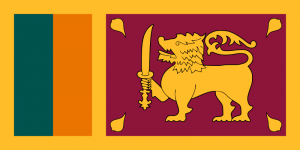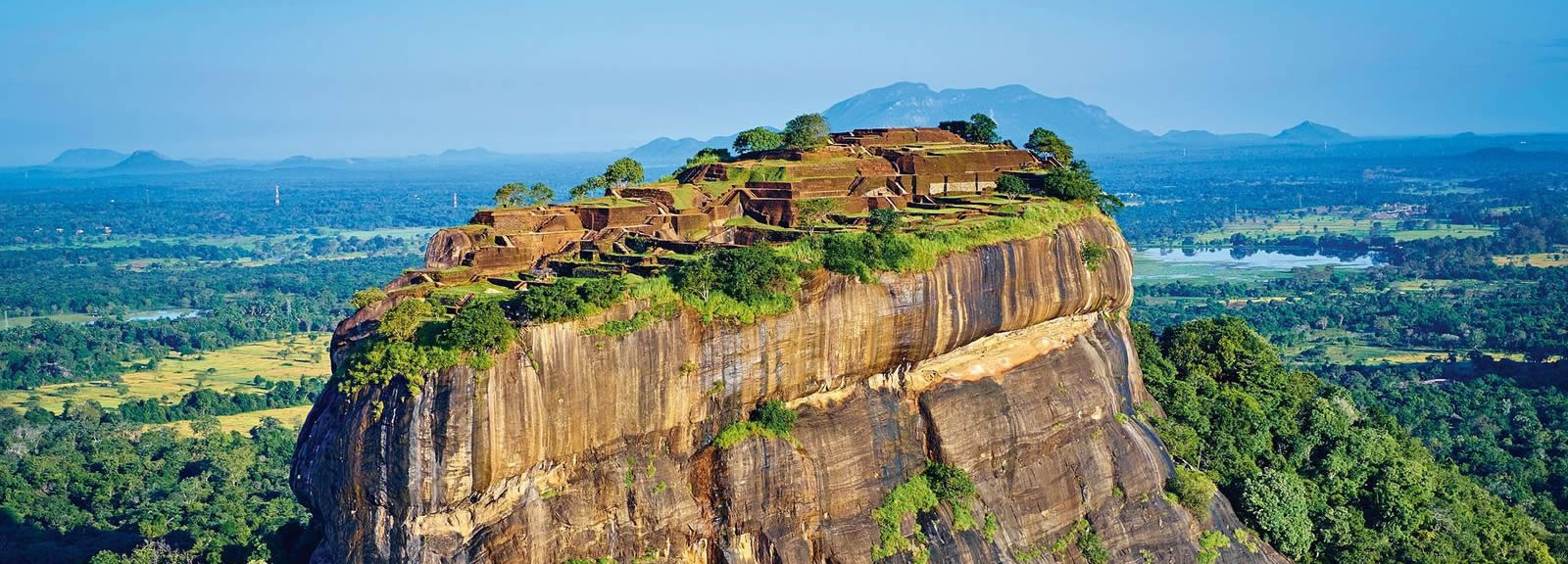Language/Sinhala/Culture/Sri-Lanka-Timeline
Interesting Facts about Sri Lanka[edit | edit source]
- Country : SRI LANKA🇱🇰
- Capital: Sri Jayawardenepura Kotte, Colombo
- Continent: Asia
- Currency: Sri Lankan rupee
- Official Language: Sinhala and Tamil
1. Sri Lanka has two nicknames: Pearl of the Indian Ocean and Teardrop of India.
2. Country has south Asia’s highest literacy rate.
3. Sri Pada(Adam’s Peak) is an important pilgrimage site known for its sacred footprint.
4. Sri Lanka is the fourth largest exporter of tea in the world.
5. One of Buddha's Teeth is housed in a temple in Kandy.
6. Cinnamon originated in Sri Lanka.
7. Sri Maha Bodhiya is the world's oldest human-planted tree(aged 2,300 years old).
8. In Sri Lanka shaking their head side to side means yes, not no.
9. Dambulla cave temple also known as the Golden Temple of Dambulla is one of the tourist attractions.
10. The cuisine of Sri Lanka is a mixture of Indian, Dutch, Persian, Arab, British, and Portuguese. It is recognized as the spiciest food in the world.
11. Volleyball is the national sport of Sri Lanka.
12. East Coast of Sri Lanka has beautiful beaches with adventurous water sports.
13. In Sri Lanka cell phones have a unique name "Celltel".
Source[edit source]
- Content Research - Ms Harshali Dhatavkar
➡ To LEARN & SHARE interesting experiences: Join the WhatsApp group
Sri Lanka Timeline[edit | edit source]
| Date | Event |
|---|---|
| Around 500 BC. AD | the island, already inhabited by the Veddas (Veddhas), is colonized by Indian rice farmers from the north (of Aryan origin) and by Tamils (of Dravidian origin). |
| Around 250 BC. AD | appearance of Buddhism in Ceylon. Tissamaharama, the capital, is founded in the south of the country. The Tamil invasions continue. |
| Around 60 BC. AD | Dambulla becomes the capital during the reign of Vattagamini Abhaya. |
| Around 200 apr. AD | introduction of Sanskrit under the reign of Voharikatissa. |
| Around 330 | arrival of the tooth of Buddha on the island. |
| 350 | rise of the Sinhalese civilization. Anuradhapura becomes the capital. |
| 480 | the Tamils are pushed out of Lanka. |
| 490 | Kasyapa revolt; the capital is established in Sigiriya. |
| 772-777 | Tamil invasions. Polonnaruwa becomes the capital. |
| 831-851 | Tamils plunder Anuradhapura. |
| 1055-1110 | King Vijaya Bahu I drives out the Tamil invaders. |
| 1153-1186 | Parakrama Bahu Ier restores Buddhism damaged by new Tamil invasions. |
| 1215-1240 | the north of the island is occupied by the Tamils. |
| 1505 | the Portuguese dominate the island, except the kingdom of Kandy. |
| 1550 | the island is divided into four kingdoms: Kotte, Sitavaka, Kandy and Jaffna. |
| 1602 | arrival of the Dutch on the island. |
| 1604-1636 | alliance of the Dutch and the Kandyans. |
| 1658 | boom in the spice trade, construction of canals. |
| 1687-1739 | the king of Kandy, Vimaladharmasuriya II, enters into resistance against the Dutch. |
| 1796 | British colonization of the coasts. |
| 1815 | Kandy comes under British rule. |
| 1817 | revolt of the kingdom of Kandy. The British seize Buddha's tooth. |
| 1828 | introduction of the cultivation of coffee. |
| 1850 | restoration of the tooth to the monks of Kandy. |
| 1867 | introduction of the cultivation of tea. |
| 1948 | independence of the island of Ceylon. Establishment of a secular state. |
| 1956 | Sinhala is introduced as the official language. |
| 1957 | Tamil, recognized as a minority language, is spoken in the administration in the North and East. |
| 1959 | assassination of President Solomon Bandaranaike. |
| 1960 | Sirimavo Bandaranaike, the president's widow, becomes Prime Minister. |
| 1964 | agreement with India on the return of Indian Tamils. 75,000 will continue until 1975. |
| 1970 | constitutional reform: the country becomes Buddhist. |
| 1971 | 15,000 dead in the Marxist insurrection led by the People's Liberation Front (JVP). |
| 1972 | Ceylon becomes the Republic of Sri Lanka. Creation of the Tamils New Tigers (TNT). |
| 1976 | TNT becomes the Liberation Tigers of Tamil Eelam (LTTE) movement. |
| 1977 | a change in the law recognizes Tamil as an official language (like Sinhala). |
| 1981 | In retaliation for the death of two Sinhalese police officers by a Tamil group, the Jaffna municipal library was set on fire by a crowd made up of Sinhalese and Sinhalese police officers. All the works are destroyed and the cultural loss is priceless. |
| 1982 | clashes in the south of the country after a year of state of emergency. |
| 1983 | attack on a military bus by LTTE rebels: 13 dead. In retaliation, the Tamil neighborhoods of Colombo were set on fire. It was the start of a conflict that would last nearly 26 years. |
| 1984 | Buddhist monks launch a campaign of total war against the Tamil Tigers. |
| 1985 | LTTE attack in Anuradhapura: 148 dead. |
| 1987 | Colombo attack: 117 dead. India-Sri Lanka agreement to send an Indian peace force to the Jaffna peninsula to disarm the Tamil rebels. |
| 1988 | election of Ranasinghe Premadasa as president. |
| 1989 | 542 political assassinations. |
| 1991 | assassination of Indian Prime Minister Rajiv Gandhi. More than 2,000 people have been killed in clashes between Tamil rebels and the Sri Lankan army. |
| 1993 | assassination of President Premadasa. |
| 1994 | Chandrika Kumaratunga, first Prime Minister, is elected president. His mother, Sirimavo, is appointed Prime Minister. |
| 1995 | a three-month ceasefire with the Tamils is broken. Army offensive in the north and LTTE attacks in Colombo. |
| 1996 | establishment of the state of emergency. Clashes in the North: 12,000 dead. |
| 1998 | victorious army offensive on the Jaffna peninsula. |
| 1999 | LTTE counter-offensive. Failed attack on Kumaratunga, who was re-elected president two days later. |
| 2000 | attacks in front of the Prime Minister's office and in Batticaloa kill several dozen people. Appointment of Ratanasiri Wickremanayake as Prime Minister. The president proposes to form a federal state. Arrival in Sri Lanka of Norwegian diplomats chosen to mediate negotiations with the Tamil parties. On December 24, the LTTE announced a unilateral ceasefire. |
| 2001 | in April, the LTTE announces the end of the unilateral ceasefire. The opposition United National Party triumphs in the general elections and Ranil Wickramasinghe is appointed Prime Minister. |
| 2002 | signature of a reciprocal ceasefire and start of peace talks under the aegis of Norwegian envoys. The parties are moving towards a very broad autonomy of the regions under Tamil control. |
| 2003 | the Tamil front announces the suspension of its participation in the negotiations. At the end of October, the leaders of the LTTE declared themselves in favor of a transitional solution of autonomous administration of the territories under their control. |
| 2004 | following the legislative victory of the UPFA (United People's Freedom Alliance) coalition, Mahinda Rajapakse becomes Prime Minister. On December 26, a devastating tsunami off Sumatra swept away nearly 30,000 Sri Lankans, leaving thousands missing. Almost a million people on the island are directly affected. International aid is rushing in, but not all disaster areas are equally rescued. |
| 2005 | a state of emergency is declared in August, after an escalation of violence leading to the assassination of the Minister of Foreign Affairs. On November 17, 2005, Mahinda Rajapakse, candidate of the SLFP, won the presidential election with 50.33% of the vote, against Ranil Wickramasinghe. |
| 2006 | large-scale attacks resume and the government decides to bomb Tamil military positions. |
| 2008 | the north of the country is under high security and many dams are installed along the roads leading to Trincomalee and Anuradhapura. On November 23, the Battle of Kilinochchi began, the administrative headquarters of the LTTE. On the 25th and 26th of the same month, Cyclone Nisha hit the Jaffna peninsula and accentuated the difficulties already caused by the war, leaving more than 340,000 victims. |
| 2009 | On January 2, the armed forces entered Kilinochchi, evacuated by the Tigers and completely deserted by its population. In early May, LTTE forces lost all the towns they controlled and were cornered in a pocket of resistance in the northeast of the country (Mullaittivu). On May 18, Velupillai Prabhakaran, the organization's historic leader, was killed by the Sri Lankan army as he tried to flee from the combat zone. The next day, President Mahinda Rajapakse proclaims the end of the civil war. |
| 2010 | on January 26, President Mahinda Rajapakse wins the presidential election and a second six-year term, facing ex-army chief Sarath Fonseka. In November, Colombo experienced the worst rainfall on record in eighteen years. Several thousand people are affected. Inauguration of the international port of Hambantota, Sri Lanka's second port after Colombo. |
| 2011 | February-April: Cricket World Cup. November: opening of the first section of the motorway (Southern Expressway E01) between Colombo and Galle. Opening of the first large hotel complexes in Passikudah, on the east coast. |
| 2012 | June: continued meteoric rise in the number of tourists visiting Sri Lanka since the end of the war. The government announces a 21.6% increase in tourist arrivals compared to the same month of the previous year. Prices are also on the rise, in particular due to higher prices for transport, oil and energy. |
| 2013 | August: attack on a mosque by Buddhist extremists in Colombo (5 injured). November: Colombo hosts the Commonwealth Heads of Government Summit. Canada refuses to go there to protest Sri Lanka's refusal to allow an international investigation into the final days of the civil war. India and then Mauritius follow suit. |
| 2014 | May 6: World Youth Conference in Colombo. June 12: attacks on Muslims by Buddhists in the Aluthgama region (5 dead), followed by demonstrations by the extremist Buddhist group Bodu Bala Sena. |
| 2015 | January: Maithripala Sirisena is elected President of the Republic, then Pope Francis visits Colombo and Madhu. February: four-day visit to India by the Sri Lankan President in order to strengthen diplomatic relations between the two countries. March: Narendra Modi, Prime Minister of India, visits Sri Lanka for the first time in twenty-eight years. August: the legislative elections are won by the United National Party which obtains 106 seats out of 225. September: the UN calls for the creation of a special "hybrid" tribunal to try crimes committed during the civil war. |
| 2016 | February: the government opens a public consultation on the Internet for the drafting of its future Constitution. May: Record floods force 500,000 people to evacuate Colombo and kill more than 100. September: WHO officially declares malaria eradicated in Sri Lanka. |
Sources[edit | edit source]
World Timelines[edit source]


